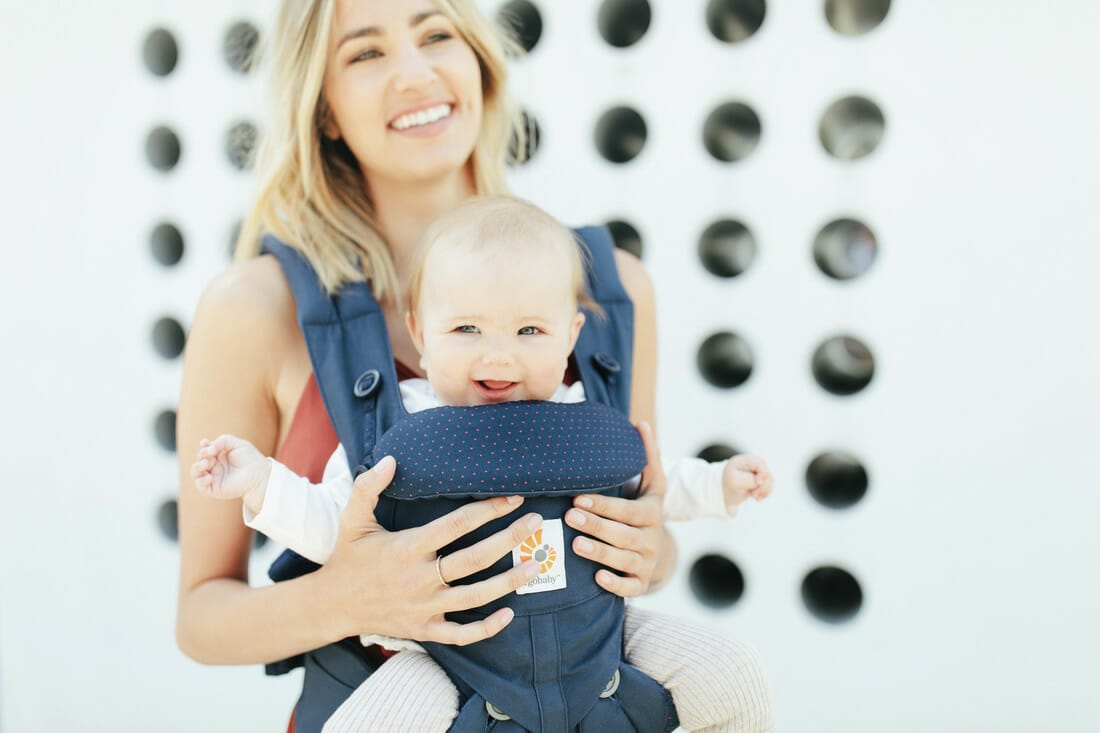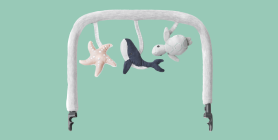
When you’re looking for a baby carrier for your newborn, you want one that’s comfortable for you and your baby; one that evenly distributes your baby’s weight and doesn’t put unnecessary pressure on your back and shoulders. But even more importantly, you want an ergonomic baby carrier because it properly and safely supports your little one.
What is an ergonomic baby carrier?
An ergonomic baby carrier supports the natural posture of babies, while encouraging healthy hip development. It should support your baby’s legs up to the backs of his knees, so his entire legs don’t dangle, but he can still freely move his lower legs as he gets a little older. An ergonomic carrier comes with a wide, comfortable base that supports your baby’s weight so more of it is on her bottom rather than her crotch and holds your baby’s hips and legs in a frog leg or M shape. In this ergonomic position, your baby’s bottom is lower than her knees, while her knees and hips are level with one another and her hips are spread open.


This wide-leg, spread-squat position benefits his comfort and proper hip development, as well as your comfort because it helps uniformly allocate his weight across your hips, back and shoulders, which you can also thank to wide, padded shoulder straps and a waist belt.
Why is an ergonomic baby carrier good for you and your baby?
With an ergonomic newborn baby carrier, you never have to worry how your baby is being held or if her developing neck, spine, pelvis, hips and legs are being supported correctly. Ergonomic baby carriers are made to provide the best support for babies and babywearers.
All About Baby Carriers for Nature Adventures
Choosing the Right Baby Carrier
When it comes to selecting the best baby carrier for summer adventures, there are several options to consider.
Types of Baby Carriers:
- Wraps: Perfect for newborns, providing a snug and secure fit.
- Slings: Ideal for quick and easy use, offering good ventilation.
- Soft Structured Carriers: Versatile and comfortable for both parent and baby, suitable for longer trips.
Emotional Benefits of Getting Outside
Spending time in nature with your baby can strengthen the bond between you. The simple act of holding your baby close, feeling their warmth, and sharing new experiences together can create strong emotional connections. It’s also a wonderful way to reduce stress and improve your mood. When my littles were extra fussy, I’d take a walk around the neighborhood. Even though I don't live in an area with trails and surrounded by nature, simply behind outside changed everything. A little vitamin D does wonders!
Cognitive Development
Nature is a sensory wonderland for babies. The different sights, sounds, and smells can stimulate your baby’s senses and promote cognitive development. Watching leaves rustle, hearing birds chirp, and feeling the texture of a tree bark can all contribute to their learning and development.
Holds your baby like you would hold him.
The best baby carrier for newborns holds and supports your baby just like if you were holding her. An ergonomic carrier should do what your arms and hands do—hold your baby tight and high up against you so you can kiss her cute head, while safely supporting your baby’s head, back, bottom and knees as you instinctively cradle her. Newborns also naturally assume the M or frog leg position, so you want a carrier that holds your baby’s lower half in that same natural position.
Reduces strain on still-developing spine, joints, ligaments and hip sockets.
Your baby’s body is still developing. Too much strain placed on her spine, joints, ligaments and hip sockets from improper positioning will not only be painful for him, but can cause future growth and health problems.
Exploring Nature with a Baby Carrier
Promotes healthy hip development.
Newborns are vulnerable to hip joint and spine damage if they’re not sitting right in a carrier, especially if they’ve been diagnosed with hips problems, like hip dysplasia. As your baby sits in her natural, M shape position, it supports better hip joint positioning and a deeper development of her hip sockets. There isn’t any strain on her shallow hip sockets or loose ligaments. To help your baby achieve that hip-healthy M shape, slightly tilt her pelvis inward and push her feet (that are below her bent knees) upward to encourage the flexed, spread-squat position of the legs as you put her into the carrier.


Advantages of Using Strollers for Nature Adventures
While baby carriers are fantastic for mobility and closeness, depending on the adventure of choice you might want to be a stroller along too.
There are a LOT of baby stroller options on the market. So we understand how confusing it can be to choose the one that’s right for your family. Not only are there a variety of brands, but a variety of strollers that serve different purposes.
There are a few types of strollers on the market:
- Full-sized stroller: This is typically the stroller parents thing of buying for all its versatility.
- Lightweight or umbrella stroller:These compact strollers are perfect for on-the-go adventures.
- Jogging stroller: Designed for parents who want to combine fitness with outdoor adventures.
- Double stroller: Designed for parents with multiple kids, especially twins.
- Car seat carrier: These strollers connect to a specific car seat. We don't typically recommend these as they can be unsafe for baby and uncomfortable for parents who are pushing.
Learn more about the types of strollers and which one would be best for you.
Allows you to babywear longer.
Because an ergonomic baby carrier evenly distributes your baby’s weight, you can comfortably carry your baby for longer sessions, as well as from the newborn stage up to his toddler years. Babywearing is convenient for you and good for your baby—but it’s only considered good when you follow the basic babywearing safety tips, like using an ergonomic baby carrier. All of Ergobaby’s baby carriers have been deemed “hip-healthy” by the International Hip Dysplasia Institute.
























